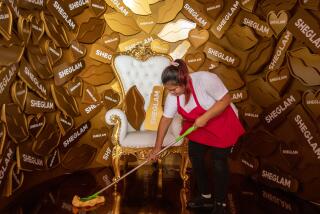Magazine Is Squeaky Clean and It’s Plain the Pane Is Not on the Wane
- Share via
EL SOBRANTE, Calif. — There’s Time. There’s Newsweek. There’s Fortune and Forbes and Playboy.
And then there’s American Window Cleaner, the magazine that proudly declares itself the “Voice of the Professional Window Cleaner.”
Huh?
That’s a typical reaction, says magazine publisher Richard Fabry. “Everybody consistently, no matter what their station in life, is surprised.”
But if you think it’s hard to fill six 40-page issues a year, you’re wrong, he says.
Since 1986, Fabry and his intrepid contributors have been reporting on the window washing industry, covering everything from tips on removing troublesome screenburn to climbing the ladder of successful high-rise work--without falling off.
In a recent issue, investigative reporters even pulled out that old journalistic standby, anonymous Washington sources, for an expose on the secrets of White House window cleaning.
Clearly, this is a magazine that’s not afraid to come clean and tell the pane truth.
“For someone who wants to learn about this industry . . . it’s the only place they can really go,” said frequent contributor Bob Williams of Cascade Window Cleaning in Portland, Ore.
As a promotion blurb puts it, “Before American Window Cleaner came on the scene in 1986, the only way to get quick industry know-how was to kidnap a window cleaner and make him or her talk.”
AWC founder Rod Woodward got the idea of a trade magazine while traveling to promote a swivel squeegee he had invented. The first issue was 5,000 sample copies of an eight-page newsletter.
The notion of providing a public forum for what had been a fragmented industry caught on quickly. The second issue doubled to 16 pages and today the magazine has a circulation of 9,000, Fabry said.
Inspired by the magazine, Texas window cleaners Jim and Jacinda Willingham decided to hold annual workshops, eventually leading to the formation of the International Window Cleaning Assn. in 1989.
The association has since tackled such problems as safety regulations and is working on getting some lobbying clout.
“Now we’re beginning to feel our power,” said Fabry.
Many AWC articles deal with serious issues, such as safety, insurance and equipment. But there is also lighter fare, such as “Your Clogs and Dogs: Staying Warm & Dry,” and “Zen and the Art of Window Cleaning.”
The July-August issue featured a composite cover showing Bill Clinton, squeegee in hand, in front of the White House.
Inside, Williams reported that the “White House window cleaner pulls his squeegee straight across the window panes!” That’s bad, because it apparently leaves a horizontal line visible to eagle-eyed peers. The article did give credit for a perfect job wiping off the mullions, slender vertical bars between the lights of windows.
Getting the information was no easy task, Williams reported. White House staff would not go on record (glassified information?) so Williams relied on sources, public documents and eyewitness accounts from his far-flung correspondents.
Among those was Bill Lussenheide, of Sunshine Window Cleaning in Menifee, Calif., who toured the White House and filed this report:
“The State Room windows looked clean; however, I looked up at the curtained fanlights over interior doorways and noticed these plates looked smoky. These windows haven’t been done in a long time.
“Maybe the White House staff doesn’t think foreign ambassadors and heads of state will notice this potential embarrassment. I would think the Queen of England would notice. Then again, Buckingham Palace had dirty windows when I visited in 1990.”
In the interests of accuracy, Williams points out that the palace wasn’t offering inside tours back then. But he notes that even from a distance, a window cleaner has an eye for grime.
All of which can only lead one to speculate that cleaning the windows at Buck House must, indeed, be a royal pane.
More to Read
Inside the business of entertainment
The Wide Shot brings you news, analysis and insights on everything from streaming wars to production — and what it all means for the future.
You may occasionally receive promotional content from the Los Angeles Times.









